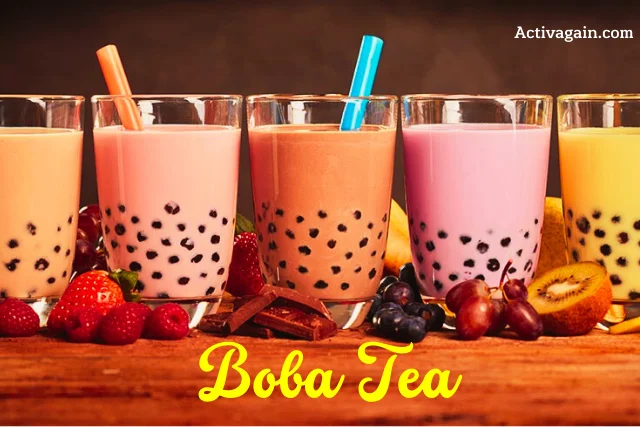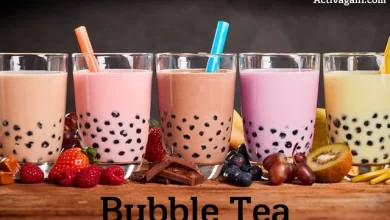
Exploring the Origins of Boba Tea: A Historical Perspective
Boba tea, or bubble tea is a drink on trend wildly in the initial years of the 1980s in Taiwan. Tapioca pearls that are chewy are used to make a drink that has tea, milk, and cane sugar in it. Most of the time, it’s served with an extra-large straw to let the pearls be sucked up the straw, and then be chewed. Boba-tea has earned a special status around the globe, being mostly loved, for its distinguished taste and texture. Thus, it is possible to find it as one of the most preferred drinks.
| Article Outline: 1. Introduction to Boba Tea 2. History and Origin 3. Ingredients and Varieties 4. Making Boba Tea 5. Popularity and Cultural Impact 6. Health Benefits and Concerns 7. Boba Tea Around the World 8. Boba Tea Trends 9. Boba Tea vs. Other Tea Drinks 10. Sustainability and Environmental Impact 11. Conclusion 12. FAQs |
History and Origin
The story of the alkalinization of boba tea appears lower back to Taichung, Taiwan, where a tea shop owner named Lin Hsiu Hui made a whim to make tapioca pearls as a special addition to her drink. The first time I had them I was mesmerized, and my admiration soon trickled down to the rest of the locals who were soon introduced to the same drink. This led to the opening of some shops that incorporated pearls in their drinks. This new dance of super-synchronous movements had a rapid spread in Taiwan and subsequently became well-known throughout Asia and across the globe.
Ingredients and Varieties
The key ingredients of boba tea are usually tea that has been infused in addition to milk, sugar, and tapioca pearls. However, numerous other types and flavors are surprisingly on different markets. For example, there are fruit-flavored drinks that can be made with either tea or a combination of milk and milk-based additives. Chandlers or something similar is used as well as jelly, pudding, and ice cream for flavor and feeling in attractive ways.
Making Boba Tea
Different production processes are essential for making boba tea. Tea Making is a first process that starts with brewing and sweetens to one’s preference. Later on, tiny tapioca pearls will be cooked until they are soft and chewy before they are added to the tea. Tonic water is then shaken or mixed with other ingredients to give the drink a fluffy, frothy nature. Furthermore, it serves the scooped dolcelatte flurry with a wide straw so that we have the pleasure of having the ice cream pearls while we enjoy it.
Popularity and Cultural Impact
In recent years, the amount of boba-tea has been seen widely, but only younger generations know about this concept. Aside from its rainbow colors, its unique flavor and fun texture with a lot of kinds of flavors could be the reason why it’s very well-loved. Nowadays, boba tea stores can be encountered almost in every town – from the very small ones to the ones in the region’s capital, thus strengthening a worldwide boba-tea culture.
Health Benefits and Concerns
However, this great taste can not exclude the fact that these drinks are high in sugar, so it is better to consume them in moderation. Similarly, boba tea is healthy to some extent. Antioxidants may come from the tea base and tapioca pearls which are also reported to be good for the stomach. Â Vital to separate the ones that are harmful and are left with healthy choices.
Boba Tea Around the World
Boba-tea’s popularity has led to the emergence of precise versions in distinct parts of the world. In America, for instance, boba-tea stores frequently provide customizable drinks with an extensive variety of flavors and toppings. In Asia, boba-tea is regularly loved as a refreshing beverage in the course of hot weather.
Boba Tea Trends
In recent years, boba-tea has grown to be a famous subject on social media, with many people sharing their precise boba creations and reports. This fashion has brought about the upward thrust of boba-tea influencers and online groups devoted to discussing and sharing statistics approximately boba tea.
Boba Tea vs. Other Tea Drinks
Boba tea is frequently used in comparison to other tea liquids, together with iced tea and milk tea. What sets boba tea apart is its precise texture and the addition of tapioca pearls, which provide an amusing and chewy element to the drink. This units it apart from other tea liquids, making it a favorite among many.
Sustainability and Environmental Impact
As boba-tea gets exposed to public perception, the debate on its impact on the environment starts to gain importance. Plastic disposal cups and straws have stirred up disquiet as a consequence of waste generation. Some boba-tea stores have launched medium biodegradable materials and have some discounts to make their customers bring their cups to be involved in this through the environmental footprint.
Conclusion
Boba tea, perhaps one of the most favorite drinks in the world, originating in Taiwan, reached the heights globe it is. It stands out for its specifically unique taste, a bit strange texture, and of course, the variety of flavors that they are available in. Teenagers can’t imagine their life without it. It is important to keep the sugar content on point and in small portions but it can be a yummy supplementary item when sipped as a good treat.
Is boba tea the same as bubble tea?
Yes, boba-tea is any other name for bubble tea. Both check with the same drink made with tea, milk, sugar, and tapioca pearls.
Are tapioca pearls in boba tea healthful?
Tapioca pearls are high in carbohydrates and calories so they need to be eaten up in moderation as a part of a balanced weight-reduction plan.
Can I customize my boba tea?
Yes, many boba-tea stores offer customizable alternatives, allowing you to select the sort of tea, sweetness level, and toppings.
Is boba tea suitable for vegans?
It relies upon the elements used. Some boba-tea shops provide vegan-pleasant alternatives, together with using plant-based milk and skipping animal-derived toppings.
How do I save leftover boba tea?
It’s first-class to eat boba-tea clean, however, when you have leftovers, save them in the fridge and devour them within a day for the great flavor and texture.

